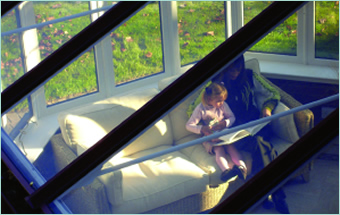Solar Control

Keeping the heat out
With large areas of glass comes another important consideration – overheating of buildings. Glass allows direct heat radiation from the sun to pass through it, known as ‘solar gain’. This has the potential to make buildings and rooms uncomfortably hot. This is often exacerbated in south facing elevations and roof glazing, as in conservatories. This may mean that air conditioning is required to cool buildings, often at great expense.
The solar gain is measured in g-values and the lower this number the better the solar control performance of the glazing. E.g. 0.34 means that the amount of solar gain is 34% or alternatively, is blocking 66% of the solar radiation. To combat this a range of solar control glazing options are available.
Solar control glazing options
The most basic is often referred to as ‘tinted glass’. This is standard float glass with a dye tint, darkening the glazing. There are bronze, blue, grey and green colours. Available in 4mm and 6mm with other dimensions subject to availability. They are also available in laminated, which is also subject to availability. Tinted glass works by adsorbing the heat thereby reducing the heat that passes through it. This is limited however, as once the heat is adsorbed, it is then radiated from the glass and this can be into the room. Additionally, tints may vary in colour as the process is variable due to production runs. Tinted glass bought for a project spread across many months or for replacements years ahead, may not be exact matches.
Newer developments are solar coatings applied to float glass in similar manufacturing processes to low e coatings. There are a wide range of coatings offering variable levels of solar performance. The coatings are generally positioned to the inside of the outside pane of a sealed unit. The coating reflects solar gain radiation back out towards its source, thus preventing the heat from entering the building. Generally, the better the solar control performance (the lower the g-value) the darker the glass usually is.
A solar control description using numbers is common. e.g. 61/34. This can be translated as 61% total light transmittance / 34% solar gain.
There are coatings that are solar control only. These can be paired with low e glass to create a cost effective solar control unit with a good thermal performance.
There are combined solar control and low e coatings that offer solar control and low e on one pane of glass. This may have a cost saving or allow a further glass type to be added to give additional properties.

